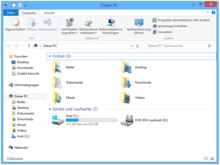Windows Explorer
| Windows Explorer
|
|
|---|---|

|
|
 Windows Explorer from Windows 8.1 |
|
| Basic data
|
|
| developer | Microsoft |
| Current version | see Microsoft Windows |
| operating system | Windows |
| category | Shell and file manager |
| License | EULA ( proprietary ) |
| German speaking | Yes |
The Windows Explorer (shortly Explorer and File Explorer called) is the default file manager and desktop environment in Windows -Betriebssystemsfamilie since Windows 95 and has since become an integral part of these operating systems.
history

Windows Explorer fulfills two tasks: On the one hand, it is a file management program and was first introduced with Windows 95 . It is thus the successor to the file manager known from Windows 3.x , which was supplied by Microsoft up to Windows ME . Already in the Windows 9x series, this previous file management program, known as the “file manager”, was no longer available as a link via the Windows start menu, but only in the Windows system directory.
In the second function, the so-called desktop is an instance of Windows Explorer:
- the working area that fills the entire screen when no window is covering it (with background image);
- the icons displayed on it;
- the system tray;
- the start menu.
However, Windows 95 (only the original or A version) offered the user the classic duo program and file manager (from Windows 3.x) as the main components of the graphical user interface and work environment ( shell ) use instead of Windows Explorer including the start menu and desktop .
The Explorer in Windows 98 ; in the foreground the opened start menu with the taskbar (below), behind it the file manager with the special folder My Computer (in the main window) and in the background the desktop
The main window in Windows XP , with the default Luna interface
Windows 7 with the desktop in the background, in front of it u. a. an open window and below the taskbar
The Explorer in Windows 8
Functions
Work surface
The Windows Explorer provides the (main) functions for the desktop to use as one of the so-called shell programs. This means that it is started after the actual operating system has started and makes the screen elements available (comparable to the panel in GNOME or Plasma in KDE ). Since Windows 95 this includes the taskbar (with the Start button for the Windows start menu ) and the actual desktop (a specially adapted system folder ), on which shortcuts and other files can be located. In Windows Server 2012 and Windows 8 , a menu ribbon was added to the interface .
In principle, all Windows operating systems of the NT line can also be used as a shell without the Explorer; In the Windows 9.x line , essential operating system functions are integrated into the GUI , so here the operating system cannot be operated without the desktop; instead, a "parallel installed" DOS version could be started.
File manager
The actual file manager is a special window view within the Explorer and not a separate program. This view is only visible in normal operation if the work surface has been started beforehand.
Alternatives
In addition to Windows Explorer, file management and shell programs from third-party manufacturers also exist for Microsoft Windows .
File manager
Shell
Individual evidence
- ↑ a b How it's done: Working with files and folders. Microsoft , accessed June 17, 2014 : "File Explorer (formerly Windows Explorer)"




